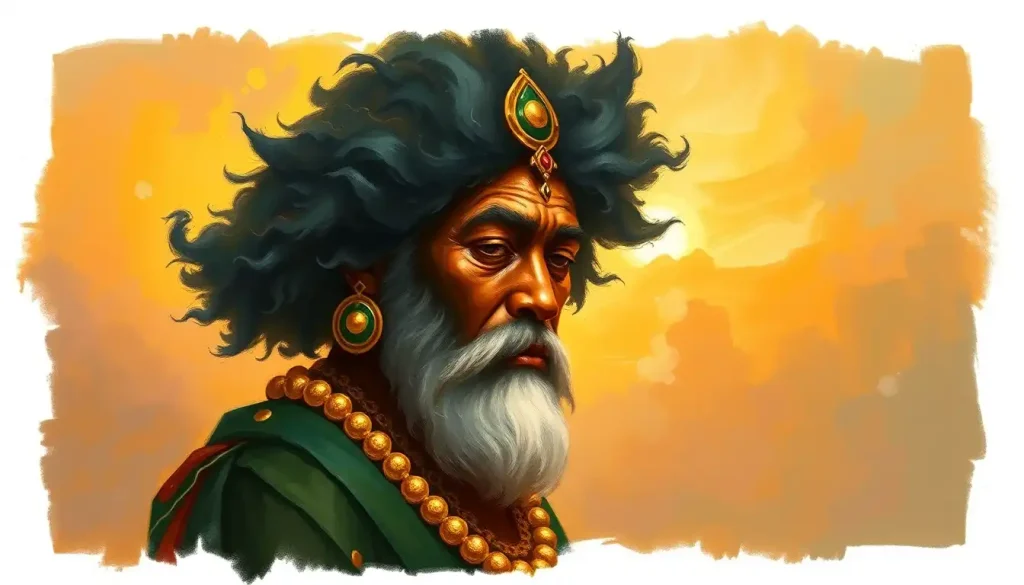While many dismiss wealth as incompatible with spiritual growth, ancient Buddhist traditions tell a fascinating story of sacred prosperity through their revered deity who transforms material abundance into a path toward enlightenment. This intriguing concept challenges our modern notions of spirituality and material success, inviting us to explore a realm where the two aren’t mutually exclusive but rather intertwined in a dance of cosmic balance.
Buddhism, often associated with asceticism and detachment from worldly possessions, actually offers a nuanced perspective on wealth and prosperity. Far from rejecting material abundance outright, Buddhist philosophy acknowledges its potential role in spiritual development when approached with wisdom and compassion. This balanced view is embodied in the form of Jambhala, the Buddhist god of wealth, whose very existence might surprise those who view Buddhism solely through the lens of renunciation.
Jambhala: The Celestial Treasurer of Buddhism
Jambhala, with his rotund belly and jolly demeanor, stands as a testament to Buddhism’s complex relationship with prosperity. Originating from ancient Indian mythology, this deity found his way into Buddhist pantheons, particularly in Tibetan and Mahayana traditions. His name, derived from the Sanskrit word “jambhara” meaning “lemon,” alludes to his ability to squeeze out the essence of prosperity, much like one might extract juice from a citrus fruit.
In Buddhist iconography, Jambhala is often depicted as a corpulent figure, seated on a lotus throne or a snow lion. His golden skin symbolizes the purity and value of spiritual wealth, while his pot-bellied appearance represents abundance and contentment. In his right hand, he typically holds a mongoose or a money bag, from which pour forth jewels and coins – symbols of material prosperity. His left hand often cradles a fruit, representing the sweetness of spiritual attainment.
Interestingly, Jambhala appears in various forms across different Buddhist traditions. In some depictions, he’s portrayed with multiple arms, each holding symbolic objects like a lemon, a banner of victory, or a trident. These variations reflect the multifaceted nature of wealth in Buddhist thought – encompassing not just material riches, but also spiritual abundance, victory over negative forces, and the power to overcome obstacles.
The symbolism associated with Jambhala goes beyond mere representations of material wealth. His imagery serves as a powerful reminder that prosperity, when approached with the right mindset, can be a tool for spiritual growth and benefiting others. The jewels and coins flowing from his money bag aren’t meant to be hoarded, but to be used wisely and generously, aligning with Buddhist principles of compassion and non-attachment.
Wealth in Buddhist Philosophy: A Path to Enlightenment?
At first glance, the concept of a wealth deity might seem at odds with core Buddhist teachings. After all, didn’t the Buddha himself renounce his princely life in search of enlightenment? However, a closer look reveals a more nuanced approach to wealth and material possessions in Buddhist philosophy.
Buddhism doesn’t condemn wealth itself, but rather the attachment to it. The Buddha recognized that extreme poverty could be as much of a hindrance to spiritual practice as excessive indulgence. Instead, he advocated for a middle path – a balanced approach that neither rejects nor clings to material prosperity.
This balanced view is encapsulated in the concept of “right livelihood,” one of the elements of the Noble Eightfold Path. Wealth as a Divine Blessing: Exploring the Spiritual Perspective on Prosperity takes on a new meaning in this context. Right livelihood encourages Buddhists to earn their living through ethical means, avoiding professions that harm others or violate moral principles. It suggests that how we acquire and use wealth is more important than the wealth itself.
The challenge, then, lies in balancing spiritual growth with material prosperity. Buddhist teachings emphasize that wealth, when acquired ethically and used wisely, can be a powerful tool for personal development and helping others. The key is to cultivate a mindset of non-attachment, viewing wealth as a means to an end rather than an end in itself.
This perspective transforms the pursuit of prosperity from a potentially spiritually harmful activity into an opportunity for growth. By approaching wealth with mindfulness and compassion, one can use material resources to alleviate suffering, support spiritual communities, and create positive change in the world. In this light, Jambhala becomes not just a god of wealth, but a guide to using prosperity as a stepping stone on the path to enlightenment.
Invoking Abundance: Rituals and Practices Associated with Jambhala
Buddhist traditions have developed various practices and rituals centered around Jambhala, aimed at invoking prosperity and abundance. These practices, far from being mere superstition, serve as powerful tools for focusing the mind on positive intentions and cultivating a mindset of abundance.
One of the most common practices is the recitation of Jambhala mantras. These sacred sound formulas are believed to resonate with the energy of the deity, aligning the practitioner with the vibrations of prosperity. The most well-known Jambhala mantra is “Om Jambhala Jalendraye Svaha,” which is chanted to invoke the deity’s blessings of wealth and abundance.
Offerings play a crucial role in Jambhala rituals. Practitioners often present symbolic gifts such as fruits, flowers, incense, and even coins or jewels. These offerings aren’t meant to “bribe” the deity, but rather to cultivate generosity and create positive karma. The act of giving, even symbolically, helps break the cycle of attachment to material possessions.
Meditation practices focused on Jambhala often involve visualization techniques. Practitioners might envision the deity in vivid detail, imagining golden light radiating from him and filling their bodies and surroundings with abundance. This visualization serves to reprogram the subconscious mind, replacing scarcity mindsets with attitudes of plenty.
It’s important to note that these practices aren’t solely focused on acquiring material wealth. They’re designed to cultivate a holistic sense of abundance, encompassing spiritual riches, wisdom, and the ability to benefit others. Angel of Wealth: Unlocking Prosperity and Abundance in Your Life explores similar concepts, highlighting the universal appeal of prosperity deities across different spiritual traditions.
A Pantheon of Prosperity: Other Buddhist Deities of Wealth
While Jambhala might be the most well-known Buddhist god of wealth, he’s not alone in the pantheon of prosperity deities. Buddhism, with its rich tapestry of traditions and cultural influences, has given rise to several divine figures associated with abundance and good fortune.
Vasudhara, whose name translates to “stream of gems,” is a goddess of wealth and abundance particularly revered in Nepalese Buddhism. Often depicted with six arms, each holding symbols of prosperity, she embodies the feminine aspect of abundance. Vasudhara is associated not just with material wealth, but also with the richness of the earth and the fertility of crops.
Kubera, originally a yaksha (nature spirit) in Hindu mythology, found his way into Buddhist traditions as a guardian of wealth and treasures. Often portrayed as a corpulent dwarf with a large belly, Kubera is considered the lord of the northern direction and the king of the semi-divine yakshas. His inclusion in Buddhist pantheons highlights the cross-pollination of ideas between Hindu and Buddhist traditions. For a deeper dive into Kubera’s role in Hindu traditions, you might find Hindu God of Wealth: Kubera’s Influence on Prosperity and Abundance an enlightening read.
The diversity of wealth deities across Buddhist traditions reflects the religion’s adaptability and its recognition of the varied human approaches to prosperity. In some schools of Buddhism, particularly those influenced by Taoism, we find figures like the Laughing Buddha or Budai, often mistaken for Gautama Buddha in the West. This jolly, rotund figure is associated with contentment and abundance, embodying the idea that true wealth lies in being satisfied with what one has.
These various deities, while different in appearance and specific attributes, share a common thread. They all emphasize that wealth, when approached with wisdom and compassion, can be a powerful force for good in the world. They remind practitioners that the ultimate goal isn’t to accumulate riches for personal gain, but to use abundance as a means to benefit all sentient beings.
Modern Applications: Buddhist Wealth Concepts in Daily Life
In our fast-paced, materially-driven world, the Buddhist approach to wealth offers a refreshing perspective that can be applied to modern life. The teachings associated with Jambhala and other Buddhist wealth deities provide practical guidelines for ethical wealth accumulation and mindful prosperity.
Incorporating Buddhist wealth principles in daily life starts with cultivating the right mindset. Instead of viewing wealth as an end goal, we can see it as a tool for personal growth and helping others. This shift in perspective can transform our relationship with money, reducing stress and anxiety associated with financial matters.
Ethical wealth accumulation is a key tenet of Buddhist economics. This involves not just avoiding illegal or harmful means of making money, but also considering the broader impact of our financial decisions. It might mean choosing investments that align with our values, supporting businesses that practice fair trade, or considering the environmental impact of our consumption habits.
Using prosperity for spiritual growth and helping others is perhaps the most profound application of Buddhist wealth concepts. This could involve setting aside a portion of our income for charitable donations, using our resources to support spiritual communities, or investing in personal development and education that allows us to be of greater service to others.
The concept that God’s Wealth Circulating in My Life: Embracing Divine Abundance takes on new meaning when viewed through a Buddhist lens. It becomes less about passive reception of divine blessings and more about actively participating in the flow of abundance, recognizing our role as conduits rather than endpoints of prosperity.
Prosperity Practices: Bringing Buddhist Wealth Wisdom into Your Life
For those intrigued by the Buddhist approach to wealth and eager to incorporate these principles into their lives, there are several practical steps you can take. These practices, inspired by the teachings associated with Jambhala and other Buddhist wealth concepts, can help foster a healthier relationship with prosperity and abundance.
1. Mindful Spending: Before making purchases, pause and reflect on whether the item truly adds value to your life or the lives of others. This practice helps curb impulsive buying and aligns your spending with your values.
2. Gratitude Journaling: Regularly write down things you’re grateful for, including material possessions. This practice cultivates contentment and helps you recognize the abundance already present in your life.
3. Ethical Investing: Research and choose investments that align with your values and have positive social or environmental impacts. This approach allows your wealth to grow while contributing to the greater good.
4. Generosity Practice: Set aside a portion of your income for charitable giving. Start small if needed, and gradually increase the amount. This practice helps break the cycle of attachment to money and cultivates joy in giving.
5. Wealth Visualization: Inspired by Jambhala meditation practices, visualize abundance flowing into your life and then outward to benefit others. This can help reprogram scarcity mindsets and foster a sense of interconnectedness.
6. Mindful Consumption: Before acquiring new possessions, consider whether you truly need them. Practice decluttering regularly, donating items you no longer need. This helps create space for abundance while benefiting others.
7. Skill Development: Invest in learning new skills or improving existing ones. This not only increases your earning potential but also contributes to personal growth and the ability to help others.
8. Abundance Affirmations: Create positive affirmations related to wealth and abundance, inspired by Buddhist teachings. For example: “I am a conduit for abundance to flow and benefit all beings.”
9. Ethical Career Choices: Reflect on your career path and consider whether it aligns with the principle of right livelihood. If not, explore ways to transition to work that is more ethically aligned and fulfilling.
10. Community Support: Engage with like-minded individuals or join groups focused on mindful wealth and prosperity. This can provide support, accountability, and opportunities for collective positive action.
Remember, the goal of these practices isn’t to accumulate wealth for its own sake, but to create a balanced approach to prosperity that supports both personal growth and the wellbeing of others. As you explore these concepts, you might find inspiration in Buddha Lucky for Wealth: Exploring Buddhist Symbols and Practices for Prosperity, which delves deeper into Buddhist symbols and practices associated with abundance.
The Global Tapestry of Prosperity Deities
While we’ve focused primarily on Buddhist traditions, it’s worth noting that the concept of divine figures associated with wealth and prosperity is nearly universal across cultures. This global tapestry of prosperity deities offers fascinating insights into how different societies view and relate to abundance.
In African traditions, for instance, we find figures like Aje, the Yoruba goddess of wealth and prosperity. Aje is believed to bestow both material and spiritual riches upon her devotees, emphasizing the interconnectedness of these two forms of abundance. For a deeper exploration of this topic, African Goddess of Wealth: Exploring Aje and Other Divine Figures of Prosperity offers valuable insights.
Japanese culture, with its unique blend of Shinto and Buddhist influences, has given rise to several prosperity deities. Ebisu and Daikoku, two of the Seven Lucky Gods, are particularly associated with wealth and good fortune. These jovial figures, often depicted with symbols of abundance like fish or rice bales, reflect a cultural attitude that views prosperity as a cause for celebration and gratitude. Learn more about these fascinating figures in Japanese God of Wealth: Exploring Ebisu, Daikoku, and Other Prosperity Deities.
The existence of prosperity deities across diverse cultures suggests a universal human desire for abundance and the recognition that wealth, when approached wisely, can be a powerful force for good. By exploring these various traditions, we can gain a richer, more nuanced understanding of our relationship with prosperity and how it intersects with our spiritual lives.
Prayers and Invocations: The Power of Intention
Across many spiritual traditions, including Buddhism, prayers and invocations play a significant role in connecting with divine energies of abundance. These practices, far from being mere superstition, serve as powerful tools for focusing intention, cultivating gratitude, and aligning oneself with the flow of prosperity.
In the context of Buddhist wealth deities like Jambhala, mantras and prayers are not about asking for material riches, but rather about invoking the qualities these deities represent – wisdom in handling wealth, generosity, and the ability to use abundance for the benefit of all beings.
For those interested in exploring this aspect of spiritual practice, Prayers for Wealth: Powerful Invocations for Financial Abundance and Prosperity offers a collection of prayers from various traditions. While the specific words may differ, the underlying intention of aligning oneself with positive energies of abundance remains consistent.
It’s important to approach such practices with the right mindset. Rather than viewing them as magical formulas for instant riches, consider them as tools for cultivating a prosperity consciousness – a state of mind that recognizes and appreciates abundance in all its forms.
The Wealth Buddha: Ancient Wisdom for Modern Times
The concept of the “Wealth Buddha,” encompassing figures like Jambhala and the principles they represent, offers a bridge between ancient wisdom and modern financial challenges. In a world often driven by materialism and short-term thinking, these teachings provide a refreshing perspective on what it means to be truly wealthy.
Wealth Buddha: Ancient Wisdom for Modern Financial Success explores how these timeless principles can be applied to contemporary financial situations. From mindful budgeting to ethical investing, the wisdom of the Wealth Buddha encourages a holistic approach to prosperity that goes beyond mere accumulation of money.
By integrating these teachings into our lives, we can develop a healthier relationship with wealth – one that recognizes its potential as a tool for personal growth and positive change in the world. This approach allows us to enjoy material comforts without becoming enslaved by them, and to use our resources in ways that benefit not just ourselves, but our communities and the world at large.
Beyond Material Riches: The Concept of Spiritual Wealth
As we delve deeper into Buddhist concepts of prosperity, it becomes clear that true wealth extends far beyond material possessions. The idea of spiritual wealth – the richness of wisdom, compassion, and inner peace – is central to Buddhist philosophy and offers a profound counterpoint to purely materialistic views of success.
Spiritual Wealth: Cultivating Inner Riches for a Fulfilling Life explores this concept in depth, offering insights into how we can cultivate a sense of abundance that transcends financial status. This inner wealth, according to Buddhist teachings, is the true source of lasting happiness and fulfillment.
Jambhala and other Buddhist wealth deities serve as reminders of this deeper truth. While they may be associated with material abundance, their ultimate gift is the wisdom to use that abundance skillfully and compassionately. They teach us that the greatest prosperity comes not from what we possess, but from how we live our lives and how we impact the world around us.
In conclusion, the Buddhist god of wealth, Jambhala, and the rich traditions surrounding him offer a fascinating lens through which to view the complex relationship between spirituality and prosperity. Far from rejecting wealth outright, Buddhism provides a nuanced approach that recognizes the potential of material resources to support spiritual growth and benefit others.
As we navigate the challenges of modern life, with its often-conflicting messages about money and success, these ancient teachings offer valuable guidance. They remind us that true wealth is not measured by the size of our bank accounts, but by the depth of our wisdom, the breadth of our compassion, and the positive impact we have on the world around us.
Whether we choose to engage with these concepts through meditation, ritual, or simply as philosophical principles, they offer a path to a more balanced, fulfilling relationship with prosperity. In a world often driven by greed and scarcity mindsets, the wisdom of Jambhala and Buddhist wealth teachings provides a much-needed antidote – a vision of abundance that uplifts not just the individual, but all of humanity.
As you continue your journey of exploration into these rich traditions, may you find inspiration to cultivate true prosperity in all aspects of your life – material, spiritual, and beyond. Remember, the ultimate goal is not to become wealthy in the conventional sense, but to become rich in wisdom, compassion, and the ability to create positive change in the world. In this light, we are all potential Jambhalas, capable of transforming the ordinary currency of our lives into the gold of enlightened action.
References:
1. Coleman, J. W. (2001). The New Buddhism: The Western Transformation of an Ancient Tradition. Oxford University Press.
2. Harvey, P. (2013). An Introduction to Buddhism: Teachings, History and Practices. Cambridge University Press.
3. Keown, D. (2003). A Dictionary of Buddhism. Oxford University Press.
4. Lopez Jr., D. S. (2001). The Story of Buddhism: A Concise Guide to Its History & Teachings. HarperOne.
5. Powers, J. (2007). Introduction to Tibetan Buddhism. Snow












Would you like to add any comments? (optional)